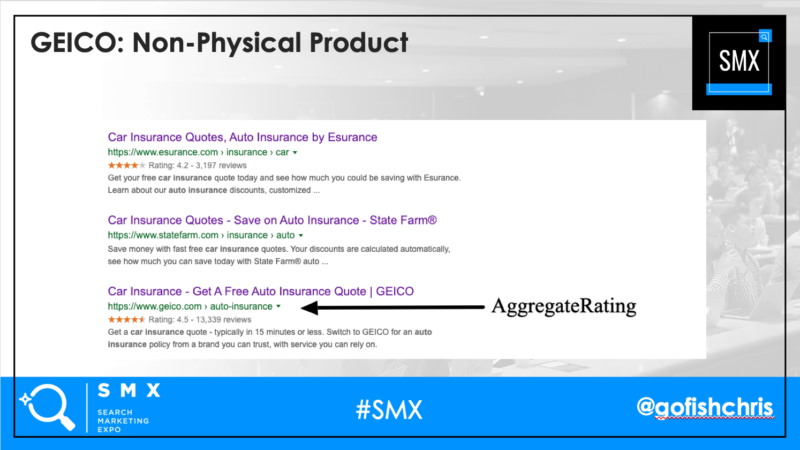A framework for SEO success with structured data
Aleyda Solis and Chris Long share their approaches to using Schema to increase organic search visibility.
NEW YORK – Simply implementing structured data is not enough to guarantee success on the search results page. Brands must have a process in place to ensure that they’re identifying the biggest opportunities, implementing Schema correctly and monitoring how search results change so that they can stay ahead of competitors, said Aleyda Solis, international SEO consultant for Orainti, during her session at SMX East on Thursday.
In addition to having a robust implementation process, brands have to get creative about which structured data types they’re using to mark up their content, said Architectural SEO Manager for Go Fish Digital Chris Long, who took to the stage after Solis to share his insights.
Long-term success with Schema
To ensure that her structured data efforts yielded the largest benefit and to cut down on introducing errors that could result in a manual action, Solis created the process below.

Identify rich results opportunities. “A good place to start is to check the SERP features that are shown within our sectors,” Solis said. SEOs should familiarize themselves with the types of rich results that can surface for target queries.
Tools such as Ahrefs, SEMrush and SISTRIX can also be used to get a better idea of the occurrence of various rich results for a given keyword as well as identify other structured data opportunities, Solis said.
Solis uses the decision tree below to focus her efforts and prioritize adding structured data to the content that is most likely to increase ROI.

Schema implementation resources. Solis recommended the following resources to help publishers implement their structured data.
- Google CodeLabs’ structured data guide
- Merkle’s Schema Markup Generator
- RankRanger’s Schema Markup Generator
- Google’s Structured Data Markup Helper
However, those using Google Tag Manager to implement their structured data should add the JSON-LD programmatically instead of directly as a <script> block, Solis recommended.

Validating Schema. In addition to the general guidelines for structured data implementation, publishers should also be familiar with the guidelines for the specific structured data types they’re looking to add. Straying away from these guidelines may preclude you from achieving the desired result or even incur a manual action, said Solis.
Publishers can validate their structured data through browser extensions, Google’s structured data testing tool or crawlers like Screaming Frog.
Monitoring. SEOs can take a look at the Google Search Console enhancement reports to identify which pages are generating valid structured data and which ones are generating errors so that they can address the most important pages first. Identifying the results that provide the most value, both from a traffic and a business perspective, will also help SEO teams make more informed decisions, Solis said.
In addition to monitoring the performance of their own rich results, Solis also recommended that brands monitor for further structured data opportunities by analyzing the search features on their targeted queries as well as the rich results won by their competitors.
Creative structured data implementation
In addition to following a sustainable implementation process, brands can seek out novel ways to apply structured data, which may help them gain more visibility on the search results page. Below are a few of the tactics that Long identified.
Product Schema. “You don’t always have to mark up a physical product with the product structured data, and it’s a common missed opportunity I see,” said Long, pointing to the example below in which AggregateRating structured data was applied to a car insurance brand.

This kind of structured data can also provide your brand with visibility opportunities that you may not have otherwise had. “This may not be where these third-party review sites want to be ranking,” Long said, “but the fact is, if they want to play in this SERP and be relevant in the above-the-fold content, they’re going to need to use the product structure data.”

Article structured data. “We’re seeing a general trend in the SERPs to rank more informational type of content as opposed product type of content — it’s a big trend we’re seeing in a lot of e-commerce sites,” said Long.
“We see a lot of content in Google Discover seems to use article structured data; we see a lot of content in Google’s Interesting Finds section seems to use that structured data type as well. We think this is going to be increasingly more important,” Long predicted.

After conducting an audit of Wikipedia, Long discovered that the site uses the mainEntity property to include a link to their Wikidata page, which contains a list of all the different topics that make up that entity.

“Basically, they’re saying, ‘Hey, Google, here’s a link between the Wikipedia and Wikidata page,’ and making it easier for Google to determine that that’s the main entity of the topic,” Long said. “I think there’s a big opportunity for us, as SEOs, to potentially even include this mainEntity property and include links back to the associated Wikidata page to better improve Google’s understanding of the core topic of our articles.”
NewsArticle Schema. This structured data type makes your content eligible for Google’s top stories carousel. Long recommended that media sites connect their content to voice devices adding speakable Schema to their headlines and subheadlines.

“This provides a very concise summary of the article that makes a lot of sense when it’s translated to a voice context,” said Long.
LocalBusiness Schema. LocalBusiness is the most general structured data type for brick-and-mortar locations, but there are also a variety of specific subtypes, such as ChildCare, Dentist, InternetCafe and many more, that can be applied to let search engines know exactly what your business does.

This Schema can also be applied to professionals: “We think that the structured data tells Google these pages may be mapped to more local SEO.” Long said. “When someone queries insurance agents, we want you to show these pages, potentially. We also think it makes it just a little easier for Google to discover the NAP data on the page.”
This may also be a viable way to scale local SEO initiatives by implementing this technique through a template, Long said.
FAQ structured data. As with any type of rich result, adding FAQ Schema may have the unintended consequence of decreasing traffic, Long said, referencing one of Path Interactive SEO Director Lily Ray’s experiences. To increase the likelihood that a user will click through, Long pointed to Ray’s advice on marking up internal links within your structured data.

“That will actually show you internal links directly in the search,” said Long. “That way, you can still get the bigger result and still entice users to click through to the actual page”
Although the number of organic clicks has been on the decline, there are still opportunities for what SMX East keynote presenter Rand Fishkin referred to as “on-SERP SEO.” Creative implementation of structured data is one method that brands can apply to provide search engines with more context and potentially reach their audiences.
Contributing authors are invited to create content for Search Engine Land and are chosen for their expertise and contribution to the search community. Our contributors work under the oversight of the editorial staff and contributions are checked for quality and relevance to our readers. The opinions they express are their own.
Related stories